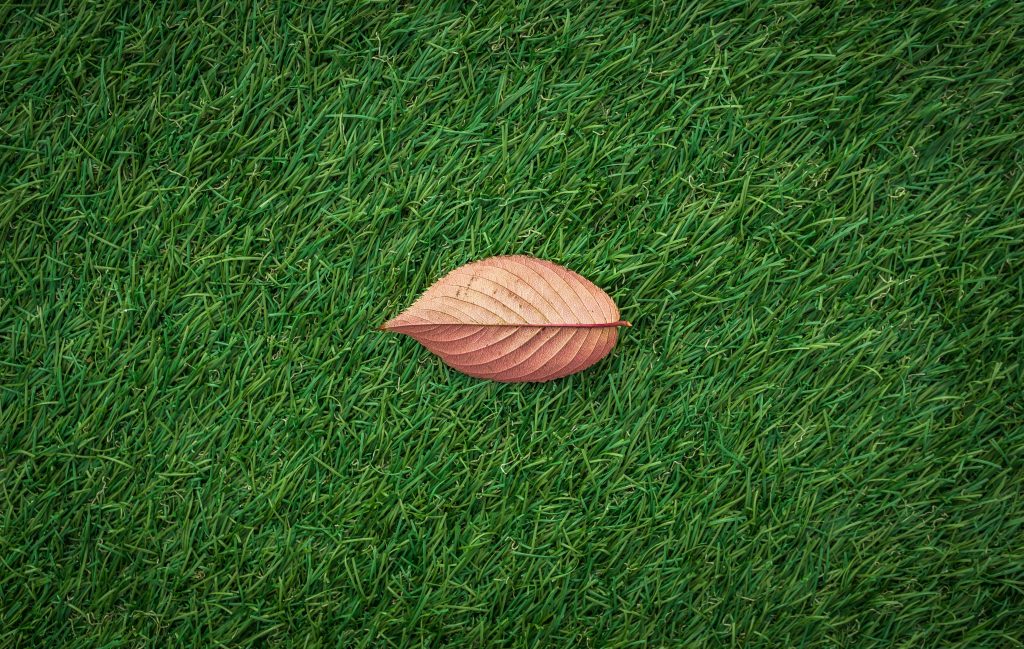
You may be surprised to learn that fall is the time many lawns will look their best. Both shoot and root growth are at their peak. Additionally, many of the largest lawn stressors like heat, drought, weeds, diseases, and insects are all starting to naturally diminish.
This makes the fall the best and most critical time to invest in the long-term health of your turf. Knowing this, here are the top 5 lawn care mistakes to avoid this fall.
Overwatering or Underwatering
As temperatures fall and the forecast includes more rain, lawns experience less drought stress than they do in the summer. If you are used to your summer watering levels, make sure you adjust accordingly as the seasons change. If you overwater your lawn with unnecessary irrigation, your turf may become susceptible to disease.
However, don’t stop watering altogether. Your lawn still needs about 1 inch of water per week, whether from rain or your sprinklers. A rain gauge can help with determining if the lawn is receiving enough water naturally. Otherwise, keep watering your lawn to avoid stressing the grassroots before the winter freeze.
Skipping Fall Fertilizing
Fertilizing your lawn during the fall is a key step to ensure its year-round health. The summer months can be harsh on your lawn. Thus, the best way to help your lawn recover and prepare for the winter is to fertilize it.
In fact, when you fertilize your lawn in the fall, you will reap the benefits next spring. Fertilizing your lawn in the fall helps the grass to grow stronger roots. Thus, giving it a base to come back in the spring and thrive.
Fall fertilizing also helps minimize the damage that winters and diseases can have on your grass. Most importantly, fertilizer provides a source of energy for the roots. This is what will help with spring green-up, which will help you enjoy a greener lawn that much sooner.
Ignoring Weeds and Debris
It can feel like you’ve reached the finish line on a summer of heavy yard maintenance. But fall is the time to shore up your lawn treatments before the grass goes dormant in the winter. Don’t let up too soon, or you will come to regret it in the spring! Homeowners who simply sit back and let Mother Nature take its course will be fighting weeds and dead spots instead of enjoying a healthy lawn come warmer months.
To fight these issues, be sure to treat your lawn with some weed control in the fall. You can also remove weeds manually. While you’re out there pulling weeds, take care to clear debris off your lawn, as well. This could mean raking leaves or moving lawn furniture. As the leaf and objects build-up, they smother the existing turf and block sunlight from reaching the blades. Lawns need as much sun as they can absorb during the autumn months to store nutrients for their winter dormancy. Light-starved grass tends to weaken and die, so make sure clearing off the lawn is part of your fall yard routine.
Cutting Your Lawn Too Short
As with the summer months, it is important not to cut your lawn too short. In the fall, your lawn will likely receive less traffic, which makes this step even more important. You may be eager to give your lawn one last super short trim before the winter. However, cutting corners here could undo a whole lot of good lawn care you’ve invested time and money into already.
When mowing your lawn, you should never cut off more than one-third of the grass blade. When it comes to mowing height, the appropriate length of grass depends on the type of grass you have. For example, Bermuda and Zoyisagrass should be cut at around 2.5 inches tall to cover the soil from direct sunlight. Cutting your lawn too short will leave it at risk for weed outbreaks, so it is important to follow the recommended guidelines for your turf variety.
Not Doing Anything
The biggest mistake we see is the absence of any fall lawn care. Fall is still a great time to grow grass in the Southeast. It is also the best time to improve the health and vigor of your lawn for next spring. However, with school starting and the holidays on the horizon, people are busy. Thus, fall also tends to be a time when people are not as focused on their lawn. Don’t let that be you!
Skipping any of your general lawncare treatments can risk damaging your lawn at its most vulnerable in the winter. For example, nutrients are incredibly important at this time of year, so fertilizing one last time is vital. There are several lawn treatments to focus your attention on in the fall to best prepare your lawn for winter. Don’t ignore them!
Avoid Lawn Care Mistakes this Fall
While the fall months may be easier on your lawn, it is still important to follow best practices. This will set you up to maintain a lush, green lawn throughout the season. Take care to avoid these five lawn care mistakes this fall and get the most out of your lawn.
Conclusion
In conclusion, fall is a critical period for maintaining and enhancing the health of your lawn. With optimal conditions for both shoot and root growth and a natural reduction in stressors like heat, drought, weeds, diseases, and insects, investing time and effort in fall lawn care is essential. However, inevitable mistakes can jeopardize the well-being of your turf. By avoiding the following top five lawn care mistakes, you can ensure that your lawn remains vibrant and resilient throughout the fall and into the next spring.
FAQs
Why is fall the best time for lawn care?
Fall is the best time for lawn care because both shoot and root growth are at their peak, and everyday stressors like heat and pests naturally diminish. Additionally, fall provides an opportunity to prepare your lawn for the winter and ensure its long-term health.
How much water does my lawn need in the fall?
While lawns experience less drought stress in the fall, it’s essential to provide about 1 inch of water per week, either through rainfall or irrigation. Overwatering can make the turf susceptible to diseases, so adjusting watering levels according to the changing seasons is crucial.
Why is fall fertilizing important for my lawn?
Fertilizing your lawn in the fall helps it recover from the harsh summer months, promotes more robust root growth, and minimizes damage from winter and diseases. The benefits of fall fertilization extend into the following spring, contributing to a healthier and greener lawn.
Why is it necessary to control weeds and clear debris in the fall?
Fall is the time to address weed issues and remove debris to prevent dead spots and weed outbreaks in the spring. Weeds compete with grass for nutrients, and debris can block sunlight, weakening the grass. Proper maintenance in the fall ensures a healthier lawn in the warmer months.
How short should I cut my lawn in the fall?
Avoid cutting your lawn too short in the fall, as this can leave it vulnerable to weed outbreaks. Follow the recommended guidelines for your specific grass type, and never cut off more than one-third of the grass blade. Maintaining an appropriate mowing height helps protect the turf and promotes overall lawn health.
Is fall a suitable time for lawn growth and care in the Southeast?
Yes, fall is an excellent time for grass growth and lawn care in the Southeast. Despite busy schedules with school and holidays, neglecting fall lawn care can risk damaging the lawn during its vulnerable winter dormancy. Focusing on essential treatments, such as fertilization, is vital for a robust and vibrant lawn.
